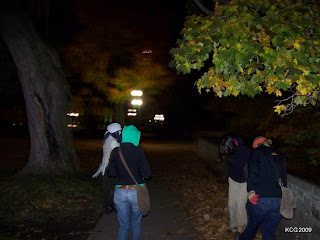The whale nerds were all able to attend the 18th Biennial Marine Mammal conference in Quebec City. The conference provided each whale nerds an opportunity to pursue workshops, presentations and view posters that interest them.
Here are a
few of my highlighted moments from the marine mammal conference:
1) Global Warming and Arctic Marine Mammals Workshop -
“Knowing how polar ecosystems change with global warming will help to develop strategies for conservation and species management. A reference collection of samples from the complete food web is being developed to build a model of trophic interactions from marine mammals down to nutrients and phytoplankton.This symposium is relevant to the Society of Marine Mammal Mammalogy's 18th biannual conference. Participants will present and review research results and progress from 2007 and 2008 field activities and discuss how to organize research findings into collaborative science capable of providing an adaptive assessment of climate change effects on Arctic marine ecosystems.”
The interdisciplinary research from the
International Polar Year (2007 – 2008) was presented during this workshop. The 2007 – 2008 International polar year (IPY) was the largest collaboration of scientific research based in the Arctic and Antarctic, with more than 60 nations participating around the globe. The Global Warming and Arctic Marine Mammals (GWAMM) research was to look at what “we” need to know to help conserve Arctic marine mammals (approximately 7 species). Therefore a variety of scientific methods were utilized to study the arctic marine ecosystems to create the platform information to examine the impacts of environmental change.
Key Point: Conservation of a unique marine ecosystem requires multiple scientific techniques and collaboration from both local Arctic communities and international nations.
2) Video Evening
The video evening provide a unique insight into the underwater environment of whales and dolphins or the frigid environment of the polar bears. The footage collected was filmed via divers with underwater video cameras or via the animals themselves with a
National Geographic crittercam . Pieter Folkens footage of a humpback whale calf nursing and bubble net feeding provided an amazing window into the intimate interaction between a cow and calf.
3) Plenary Session – “The Calvin Project, Endangered Species Recovery Through Education”; William T. McWeeny, Meredith Houghton, Madison Koos
The
Calvin Project of Adams School is a unique after school program that raises awareness on the plight of the Endangered Northern Right Whale. The Calvineers utilize their scientific knowledge to put together educational presentations for other students, politicians and even researchers to assist in the recovery of the Northern Right Whales. Education is proving to be a valuable to key in promotion of conservation and international policy decisions about the marine environment. The future of the marine environment relies heavily of the education of both children and adults.
Of course, the whale nerds made sure to take advantage of time together:
1) Tadoussac whale watching – each adding a new species or more to their
marine mammal list.
2) Ghost tour – why not when you are in one of the oldest cities in Canada.
3) Wine in the hostel via “paper cups.”
4) Opportunity to explore the city and for those with the later flights…a chance to go to the Aquarium du Quebec.
Note: I apologize for the lack of photos in this blog posting but I lost my pictures from the trip. Please refer to prior post to enjoy the photos from the trip.







































































